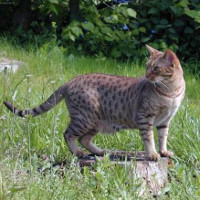 |
Ocicat |
|
TranslationFrancis Vandersteen |
||
OriginThe Ocicat is a breed of cat native to the United States. |
| This medium-sized cat is characterized by its mottled fawn coat, reminiscent of the Ocelot. |
A brief historical overview |
| The Ocicat was created in 1964 in the United States by a breeder, Mrs. Virginia Daly. She wanted to breed Siamese tabby point cats, so she crossed an Abyssinian-Siamese mix with a chocolate Siamese. Among the kittens in the litter, she obtained a male with a very original coat reminiscent of an Ocelot. He was castrated, however. Meanwhile, other breeders crossed Abyssinians, Siamese, Orientals, Egyptian Mau and American shorthair to obtain a cat resembling today's Ocicat. The breed was then called “Ocicat”, a contraction of “ocelot” and “cat”. TICA and CFA recognized the breed in 1986. The first Ocicat arrived in France in 1989, but it remains rare there, unlike in its country of origin, where it is very popular. |
General appearance |
| The Ocicat is a medium-sized cat with a well-balanced, medium-line profile. Powerful muscles give it an athletic appearance. |
Behavior / characteristics |
| Character traits are not described in the standards and are temperaments generally observed in the breed. They remain entirely individual and are above all a function of each cat's history. The Ocicat is described as sociable with humans and other animals, affectionate and very active. It doesn't tolerate solitude, and is often referred to as a “dog-cat”. It is said to be as affectionate as the Siamese, but not as expressive. |
Head |
||
Cranial region |
||
Head |
From the front, the head forms a softened triangle, with pronounced cheekbones and a square muzzle. When viewed from the side, a slight dip between the forehead and nose is noticeable, but there should be no sharp break. | |
Facial region |
||
Eyes |
The eyes are oval, set at a slight angle and set wide apart. All colors are acceptable except blue. | |
Ears |
Medium-sized, preferably with feathering at the tip. | |
Body |
||
Generality |
The body is long. | |
Back |
Straight back. | |
Tail |
| Medium to long, fairly thick at the base, tapering to the tip. |
Limbs |
| The legs are of medium length and well muscled. | ||
Forequarters |
Hindquarters |
||
Generality |
The hind legs are slightly longer than the front legs. | |
Feet |
| The feet are oval and proportionate to the body. |
Coat |
||
Coat and texture |
The coat is short and close to the body. The coat is fine but dense. The only permitted pattern is spotted tabby. | |
Color and ticking |
The breed has seven colors: brown (genetically black), blue, chocolate, lilac, cinnamon and fawn. Each variety has dark patches in keeping with the rest of the lighter coat. The latter is made up of ticked hairs, i.e. alternating light and dark stripes on the same hair. A little apart, the silver variety exists in all six of the above-mentioned varieties. The special feature of an Ocicat silver is its very light, almost white background coat, which reinforces the contrast with the spots. |
|






 English (United Kingdom)
English (United Kingdom)